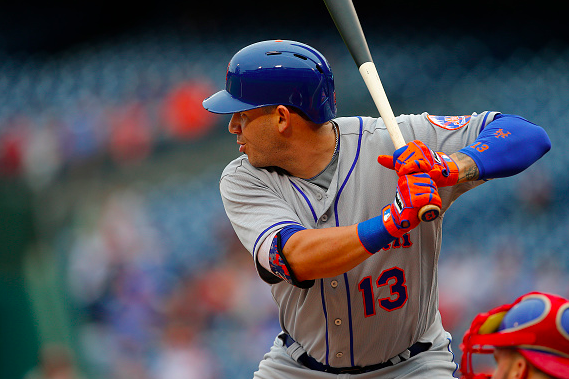New York Mets shortstop Asdrubal Cabrera has been with the organization for just one season, but he’s instantly become a fan favorite. A strong April helped start his tenure on a positive note, but it was an epic late-season surge that instantly brings a smile to every Mets fan.
It’s interesting how one player transformed from being the biggest rally killer to the team’s most dependable run producer, but that’s a microcosm of the Mets’ 2016 performance.
His turnaround can be credited toward a number of things, but there was one specific area that tells a lot of the story.
2016 Was Like a Ride at Six Flags
This season was literally a roller coaster for the Amazins:
It's literally been a roller coaster for the #Mets this season. Amazing that they're in the driver's seat right now. #LGM pic.twitter.com/PKnkObF3OL
— Matt Musico (@mmusico8) September 29, 2016
Coincidentally enough, Cabrera’s month-by-month production basically mirrors the team’s overall performance:
When manager Terry Collins and the Mets woke up on August 20, all hope seemed lost – they were 60-62 and it felt like players were going on the disabled list faster than they could score runs.
But against all logic, Cabrera, Jose Reyes and Yoenis Cespedes returned from the DL and helped fuel a 27-13 finish, grabbing one of the two available National League Wild Card berths. All three played a major role in bringing the offense back to life, but it wouldn’t have happened without Cabrera.
The shortstop landed on the DL with a troublesome left knee at the start of August. Up to that point in the season, he was hitting .255/.308/.410 with 13 home runs and 33 RBI in 373 at-bats. Upon returning on August 19, he wore opposing pitchers out to the tune of a .345/.406/.635 triple slash with 10 home runs and 29 RBI in just 148 at-bats.
Is that the kind of production Mets fans should expect from Cabrera in 2017? Probably not since it’s a small sample size, but there are reasons to be encouraged about how this hot streak began and lasted for the final six weeks.
The Knee Injury Might Have Actually Helped
It’s not surprising to see increased plate discipline accompany Cabrera’s success as the Mets battled all the way back to earning a spot in the playoffs. Timothy Finnegan of Amazin’ Avenue touched on this, but here’s how the switch-hitter’s numbers stack up, pre- and post-DL:
Getting rest helped, but hitting coach Kevin Long actually thought Cabrera’s knee injury aided his increased discipline. How could that be possible?
James Wagner of the New York Times notes that Long felt the injury forced him to be more mindful of his body, meaning he didn’t swing so hard and zeroed in more on pitches he could do damage with. Listening to one’s body and pushing to the limit when the chance of success was greatest is something only a veteran could do well.
Having more discipline at the plate is an obvious cause for Cabrera’s second-half surge, but at the end of the day, it was how he attacked fastballs that made a huge difference.
He Attacked Fastballs and Was Very, Very Successful
From 2013-15, here’s how Cabrera performed against fastballs (all stats courtesy of Brooks Baseball):
Now, take a look at how these numbers transformed throughout 2016:
Cabrera’s slugging percentage on changeups also increased from .450 before his DL trip to .737 upon returning, with about 100-point increase in isolated slugging percentage. However, watching his ISO on fastballs jump over 200 points is the most eye-popping of all.
Hitting second in the order helped – Reyes also got hot after returning from the DL. Having speed consistently on the bases and a power threat like Cespedes hitting behind him meant better pitches to hit.
Anyway you slice this, Asdrubal was just red-hot over the season’s final six weeks. He showed more patience, but was selectively aggressive and did more damage by swinging at better pitches.
He’s Been Worth Every Penny
When news broke last winter that the Mets agreed to a two-year, $18.5 million deal with Cabrera (along with an option for a third year), it made me scratch my head. When looking at the numbers – offensively and defensively – he looked awfully similar to Wilmer Flores.
That’s why it was one of my most questionable offseason moves prior to Opening Day. It seemed like this money could’ve been spent elsewhere, but I was wrong. He immediately became a leader in the clubhouse and his defense is certainly not as bad as the numbers say.
His range isn’t the best and advanced metrics view him negatively (-7 defensive runs scored and -4.2 Ultimate Zone Rating in ’16), but even with a bum knee, he was dependable on plays that should be made.
In 2015, Flores made 94.6 percent of routine plays and 78.9 percent of plays that should’ve likely been completed (60-90 percent chance of success) at shortstop. In 2016, Cabrera made 97.8 percent of routine plays and 89.3 percent of plays that should’ve likely been completed. That’s a huge difference.
New York has struggled to find a viable shortstop once Reyes left via free agency following the 2011 season, but Cabrera has finally stabilized it for the time being. Based off the length of his contract, it could act as a perfect bridge to top prospect Amed Rosario landing in the big leagues, who just hit .341/.392/.481 through 214 at-bats in Double-A.
The future at shortstop is bright, but thanks to a clever move by the Mets and some adjustments from Cabrera, the present also doesn’t look nearly as uncertain anymore.
Statistics courtesy of Baseball-Reference and advanced statistics courtesy of FanGraphs unless otherwise noted.
Thanks for reading! If you’d like to jumpstart your sportswriting career and aren’t sure how, check out my eBook. Don’t forget to follow me on Twitter so we can chat about baseball: @mmusico8.
Add The Sports Daily to your Google News Feed!




